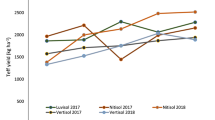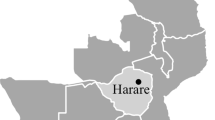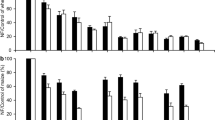Abstract
Different fields within a farm have been observed to have different soil fertility status and this may affect the response of a maize crop to applied N, P, and K fertiliser. A limiting nutrient trial was carried out at six farms each, in three districts of Western Kenya. In each of the farms, the following treatments were laid out in three fields with different soil fertility status at different distances from the homestead (close, mid-distance, remote fields): no inputs, application of NPK, NP, NK, or PK fertiliser (urea, triple super phosphate, KCl) to maize. Total soil N decreased at all sites with distance to the homestead (from 1.30 to 1.06 g kg−1), as did Olsen-P (from 10.5 to 2.3 mg kg−1). Grain yields in the no-input control plots reflected this decrease in soil fertility status with distance to the homestead (from 2.59 to 1.59 t ha−1). In the NPK treatments, however, this difference between field types disappeared (from 3.43 to 3.98 t ha−1), indicating that N and P are the major limiting nutrients in the target areas. Response to applied N was related to the soil total N content in Aludeka and Shinyalu, but not in Emuhaia, probably related to the high use of partially decomposed organic inputs with limited N availability. Consequently, response to applied N decreased with distance to the homestead in Aludeka (from 0.95 kg kg−1 relative yield to 0.55 kg kg−1) and Shinyalu (from 0.76 kg kg−1 to 0.47 kg kg−1), but not in Emuhaia (from 0.75 kg kg−1 to 0.68 kg kg−1). Response to applied P was related to the soil Olsen-P content at all sites. While for farms with a relatively high Olsen-P gradient, response to applied P decreased with distance to the homestead (from 0.99 kg kg−1 to 0.68 kg kg−1), large variability in Olsen-P gradients across field types among farms within a specific site often masked clear differences in response to P between field types for a specific site. Clear scope for field-specific fertiliser recommendations exists, provided these are based on local soil knowledge and diagnosis. Scenario analysis, using farm-scale modelling tools, could assist in determining optimum allocation strategies of scarcely available fertiliser for maximum fertiliser use efficiency.
Similar content being viewed by others
References
Anderson J.M. and Ingram J.S.I. (1993). Tropical Soil Biology and Fertility: A Handbook of Methods. CAB International, Wallingford, UK
Carsky R., Jagtap S.S., Tian G., Sanginga N. and Vanlauwe B. (1998). Maintenance of soil organic matter and N supply in the moist savanna zone of West Africa. In: Lal, R. (eds) Soil Quality and Agricultural Sustainability, pp 223–236. Ann Arbor Press, Chelsea, Michigan
Deckers J. (2002). A systems approach to target balanced nutrient management in soilscapes of sub-Saharan Africa. In: Vanlauwe, B., Diels, J., Sanginga, N. and Merckx, R. (eds) Integrated sub-Saharan Africa: From Concept to Practice, pp 47–62. CABI, Wallingford, UK
Dembelé I., Koné D., Soumaré A., Coulibaly D., Koné Y., Ly B. and Kater L. (2000). Fallows and field systems in dryland Mali. In: Hilhorst, T. and Muchena, F. (eds) Nutrients on the Move. Soil Fertility Dynamics in African Farming Systems, pp 83–102. International Institute for Environment and Development, London
Giller K.E., Rowe E., de Ridder N. and van Keulen H. 2005. Resource use dynamics and interactions in the tropics: Scaling up in space and time. Agric. Syst. In press.
(2003). An assessment of fertiliser prices in Kenya and Uganda: domestic prices vis-à-vis international market prices. IFDC, Muscle Shoals USA
Murage E.W., Karanja N.K., Smithson P.C. and Woomer P.L. (2000). Diagnostic indicators of soil quality in productive and non-productive smallholders fields of Kenya's Central highlands. Agric. Ecosyst. Environ. 79: 1–8
Prudencio C.Y. (1993). Ring management of soils and crops in the west African semi-arid tropics: the case of the Mossi farming system in Burkina Faso. Agric. Ecosyst. Environ. 47: 237–264
(1992). The MIXED procedure. SAS Technical Report P-229: SAS/STAT Software: Changes and Enhancements. SAS Institute Inc., Cary NC USA
Shepherd K.D. and Soule M.J. (1998). Soil fertility management in west Kenya: dynamic simulation of productivity, profitability and sustainability at different resource endowment levels. Agric. Ecosyst. Environ. 71: 131–145
Shepherd K.D., Ndufa J.K., Ohlsson E., Sjogren H. and Swinkels R. (1997). Adoption potential of hedgerow intercropping in maize-based cropping systems in the highlands of western Kenya. I. Background and agronomic evaluation. Exp. Agric. 33: 197–223
Smaling E.M.A. and Stoorvogel J.J. (2002). Decision making on integrated nutrient management through the eyes of the scientistthe land-user and the policy maker. In: Vanlauwe, B., Diels, J., Sanginga, N. and Merckx, R. (eds) Integrated sub-Saharan Africa: From Concept to Practice, pp 265–284. CABI, Wallingford, UK
Tittonell P., Vanlauwe B., Leffelaar P.A., Rowe E. and Giller K.E. 2005a. Exploring diversity in soil fertility management of smallholder farms in western Kenya. I. Heterogeneity at region and farm scale. Agric. Ecosyst. Environ. In Press.
Tittonell P., Vanlauwe B., Leffelaar P.A., Shepherd K.D. and Giller K.E. 2005b. Exploring diversity in soil fertility management of smallholder farms in western Kenya. II. Within-farm variability in resource allocation, nutrient flows and soil fertility status. Agric. Ecosyst. Environ. In press
Vanlauwe B., Nwoke O.C., Diels J., Sanginga N., Carsky R.J., Deckers J. and Merckx R. (2000). Utilization of rock phosphate by crops on a representative toposequence in the Northern Guinea savanna zone of Nigeria: response by Mucuna pruriens, Lablab purpureus, and maize. Soil Biol. Biochem. 32: 2063–2077
Vanlauwe B., Diels J., Sanginga N. and Merckx R. (2002a). Integrated Plant Nutrient Management in sub-Saharan Africa: From Concept to Practice. CABI, Wallingford, UK
Vanlauwe B., Diels J., Lyasse O., Aihou K., Iwuafor E.N.O., Sanginga N., Merckx R. and Deckers J. (2002b). Fertility status of soils of the derived savanna and northern guinea savanna and response to major plant nutrients, as influenced by soil type and land use management. Nutr. Cycl. Agroecosyst. 62: 139–150
Vanlauwe B., Palm C.A., Murwira H.K. and Merckx R. (2002c). Organic resource management in sub-Saharan Africa: validation of a residue quality-driven decision support system. Agronomie 22: 839–846
Vanlauwe B., Sanginga N., Giller K.E. and Merckx R (2004). Management of nitrogen fertiliser in maize-based systems in subhumid areas of sub-Saharan Africa. In: Mosier, A.R., Syers, J.K., and Freney, J.R. (eds) Agriculture and the Nitrogen Cycle, pp 115–127. Island Press, Washington, USA
Woomer P.L., Bekunda M.A., Karanja N.K., Moorehouse T. and Okalebo J.R. (1998). Agricultural resource management by smallholder farmers in East Africa. Nat. Resour. 34: 22–33
Author information
Authors and Affiliations
Corresponding author
Rights and permissions
About this article
Cite this article
Vanlauwe, B., Tittonell, P. & Mukalama, J. Within-farm soil fertility gradients affect response of maize to fertiliser application in western Kenya. Nutr Cycl Agroecosyst 76, 171–182 (2006). https://doi.org/10.1007/s10705-005-8314-1
Received:
Accepted:
Published:
Issue Date:
DOI: https://doi.org/10.1007/s10705-005-8314-1




